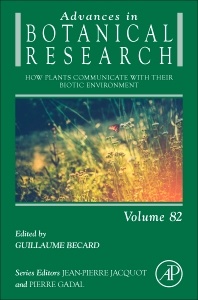Description
How Plants Communicate with their Biotic Environment
Author: Becard Guillaume
Language: English
Subjects for How Plants Communicate with their Biotic Environment:
Keywords
ABA; Agroecology; Allelochemicals; Allelopathy; Appressorial; Attractant; Batesian mimicry; Common mycorrhizal networks; Communication; Core microbiome; Deception; Defence; Eavesdropping; Ecological succession; Ectomycorrhiza; Endomycorrhiza; Epigenetics; Extra-radical mycelium; Floral filter; Floral signalling; Flower mimicry; Flower visitor; Flower; Frankia; Germination; Giant cells; Haustorium inducing factors; Herbivore; Holobionts; Honesty; Induction; Insect-plant-PGPR tritrophic interactions; Key words; Metabolomics; Mimicry; Molecular dialogs; Multitrophic interactions; Mycorrhizal fungi; Nematode effector proteins; Nterminus; Oomycetes; Parasitic plants; Parasitoid; PGPR; Phyllosphere; Phytophthora infestans; Plant invasion; Plant microbiota; Plant to plant communication; Plant; Plant-microorganisms interactions; Plant-parasitic cyst and root-knot nematodes; Plant-plant communication; Plant-plant interactions; Pollinator; Predator; Preference; Rhizobacteria; Rhizobium; Rhizosphere; SA; Secondary metabolites; Sensory exploitation; Signal standardization; Spermosphere; Strigolactones; Superorganism; Symbiosis; Syncytium; Ustilago maydis; Volatile organic chemicals (VOCs)Volatile organic compounds
Support: Print on demand
Description
/li>Contents
/li>Biography
/li>Comment
/li>
Part 1: Plant-Plant Communication1. From the Lab Bench to the Forest: Ecology and Defence Mechanisms of Volatile-Mediated ‘Talking Trees’2. Allelopathy and the Role of Allelochemicals in Plant Defence3. Communication Between Host Plants and Parasitic Plants4. Plant–Plant Communication Through Common Mycorrhizal Networks
Part 2: Plant Communication With Microbes5. Plant Communication With Associated Microbiota in the Spermosphere, Rhizosphere and Phyllosphere6. Chatting With a Tiny Belowground Member of the Holobiome: Communication Between Plants and Growth-Promoting Rhizobacteria7. Effector-Mediated Communication of Filamentous Plant Pathogens With Their Hosts8. Commonalities in Symbiotic Plant-Microbe Signalling
Part 3: Plant Communication With Animals9. Plant–Pollinator Communication10. Mimicry and Deception in Pollination11. Plant Communication With Herbivores12. Communication of Sedentary Plant-Parasitic Nematodes With Their Host Plants
- Gathers, under a common general outline, a comprehensive knowledge issued from distinct scientific communities
- Combines three life science disciplines, including ecology, evolutionary biology, and molecular biology
- Addresses a topical subject as the natural biological processes described represent basic knowledge that help develop low input sustainable agriculture
- Written by renowned scientists in their field




